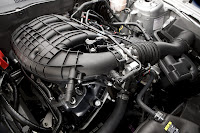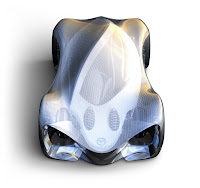- For 2011, Mustang makes sports coupe news with a new high-performance, all-aluminum Duratec® 3.7-liter DOHC Ti-VCT V-6 that delivers 305 horsepower and an expected best-in-class 30 mpg highway with six-speed automatic transmission – no other vehicle in the industry can beat that combination
- Six-speed transmissions – manual and automatic – combine with newly standard limited-slip differential and revised suspension for road-carving driving dynamics and handling
- New technology and convenience features include: Standard integrated spotter mirrors; message center; MyKey™ programmable vehicle key; and Universal Garage Door Opener
For 2011, Mustang’s new 3.7-liter Duratec 24-valve V-6 uses advanced engineering to deliver its power and economy: Twin Independent Variable Camshaft Timing (Ti-VCT) adjusts the valvetrain in microseconds. Aluminum construction means light weight. It’s an engine designed to crank out torque down low, rev to 7,000 rpm and deliver the mechanical music sports coupe lovers crave everywhere in between.
“Mustang is completely transformed with this new engine,” said Derrick Kuzak, group vice president, Global Product Development. “Everything people love about the car is still there and now under the hood is a V-6 engine that uses premium technology to deliver the power, the feel, the fuel efficiency, even the sound of the best sports coupes in the world.”
New 3.7-liter V-6 engine
With Ti-VCT operating its four valves per cylinder, the new Mustang V-6 powerplant sends significantly more horsepower and torque (305 hp and 280 ft.-lb.) to the rear wheels than its predecessor – despite its smaller displacement. The behind-the-wheel feel is unlike any Mustang ever produced.
“This new V-6 engine really speaks to what Mustang is all about,” said Barb Samardzich, Ford vice president of global powertrain engineering. “It produces power everywhere in the rev range and loves to be pushed hard. The Duratec 3.7-liter builds on our promise to use advanced technology to deliver both power and fuel economy.”
The high output is due largely to Ti-VCT which allows variable control of valve operation across the rev range. The variable cams operate on a Direct Acting Mechanical Bucket (DAMB) valvetrain using polished buckets and roller finger followers to reduce friction. The end result is as much as a 3 percent improvement in fuel economy and a 10 percent improvement in power output versus traditional engines without these advanced features.
Ti-VCT is complemented by special-tuned composite upper and lower intake manifolds for efficient air delivery and lighter weight. Ignition power is delivered by a high-energy coil-on-plug design, while piston-cooling jets and a lightweight die-cast aluminum cylinder block improve the durability and efficiency of the 3.7-liter V-6 design.
Performance was the mantra for every aspect of engine design. A cold air induction system and dual exhaust give the 3.7 its free-breathing style with a 7,000 rpm redline and near-instantaneous response to throttle inputs.
A die-cast aluminum deep-sump oil pan provides 10,000-mile oil change intervals, saving drivers money on maintenance and resulting in less waste in oil disposal.
Engineers also worked to ensure aggressive, high-performance sounds come from the new engine, from intake to exhaust. Not only does the retuned air intake system minimize losses, it also provides the driver with a satisfying intake rush on hard acceleration. The all-new dual exhaust system is mellow at idle but opens up with a howl at full-tilt, letting Mustang drivers know they’re behind the wheel of a world-class sports coupe.
“This car marks a new type of Mustang,” said David Pericak, Mustang chief nameplate engineer. “We’re using a high-performance quad-cam V-6 with all the bells and whistles in a car that’s become legendary for its handling and roadholding; it’s really going to get a lot of new sports coupe fans excited about Mustang, some for the first time ever.”
Powertrain improvements
Drivers can get the most out of the new V-6 engine’s output using either an all-new six-speed manual gearbox or a six-speed automatic transmission. Both come with the flexibility and fuel economy benefits of six forward ratios regardless of whether buyers want to shift for themselves or not.
Drivers who prefer a manual gearbox will enjoy the short throws and direct feel of the shifter along with the relaxed cruising permitted by the extra top gear ratio. Customers choosing the automatic will be pleasantly surprised to find the advanced six-speed 6R60 transmission does not sacrifice fuel economy – or performance – for convenience, delivering an expected 30 mpg highway with crisp, quick shifts that maximize torque and horsepower.
The automatic transmission also features a grade-assist or “hill mode” to improve drivability on hilly terrain. This technical innovation uses vehicle input – acceleration, pedal position, vehicle speed and brake status – to automatically determine the correct gear ratio while on an incline or decline. Hill mode eliminates sixth gear, extends lower gear operation on uphill climbs, and provides additional grade or engine braking for coast downs.
The standard 2.73 rear axle provides an ideal blend of cruising fuel economy and acceleration, aided by the wide ratio spread permitted through the use of six forward speeds in the gearboxes. Performance enthusiasts can select an available 3.31 rear axle ratio for better off-the-line launch characteristics.
Fuel economy improvements
Extra horsepower and refined engine operation will be the most noticeable features to new 2011 Mustang 3.7-liter V-6 buyers while projected class-leading fuel economy, also a standard feature, offers an additional bonus. The numbers speak for themselves:
- 19 mpg city/30 highway with six-speed automatic transmission, up from 16 mpg city/24 highway on the 2010 model with automatic – a 25 percent improvement over 2010
- 18 mpg city/29 highway with six-speed manual transmission, up from 18 mpg city/26 highway on the 2010 model with manual
- The new Electric Power Assist Steering (EPAS) system which eliminates the drag of an engine-operated hydraulic power steering pump
- Six-speed transmissions that allow lower cruising revs without sacrificing off-the-line performance
- Aerodynamic improvements such as a new front fascia, tire spats on the rear wheels, modified underbody shields, a taller air dam and an added rear decklid seal
With so much additional horsepower standard, the 2011 Mustang received enhancements to its chassis to maintain the outstanding balance and driving behavior Mustang owners expect. Damper tuning and spring rates were revised to provide a smooth highway ride while a new rear lower control arm and stiffened stabilizer bar bushings improve stiffness and handling for better cornering response.
While Mustang’s aerodynamic improvements were designed mainly to improve fuel economy, engineers also adjusted the vehicle’s front/rear lift balance. The result is a car that tracks more securely and feels more “planted” to the road surface at higher speeds, helping to keep the tires in better contact with the pavement.
The addition of EPAS marks a new era in driving dynamics for Mustang owners. Steering effort at parking lot speeds is reduced, while high-speed and highway feel is improved for more precise steering and handling. Because the belt-driven power steering pump is eliminated, EPAS provides a quieter vehicle with fewer components drawing engine power.
EPAS also enables new technologies that adjust for minor driving annoyances. Pull-Drift Compensation adjusts the steering to correct for crosswinds and minor road crowning, while Active Nibble Control helps eliminate the “shimmy” felt at high speeds when a wheel is out of balance or a brake rotor is warped. Both conditions are alleviated by EPAS independent of driver input, helping ensure Mustang delivers a smooth, comfortable driving experience in all conditions.
Mustang buyers choosing the new V-6 will also get a standard limited-slip differential that provides better handling and more sure-footed grip in poor weather conditions by directing engine torque to the rear wheel with the most traction. When the time comes to slow things down, the 2011 Mustang is also equipped with larger four-wheel ABS disc brakes, with 11.5 inch front and 11.8 inch rear rotors.
Refinements complement advanced features
To reinforce the sporty nature of the 2011 Mustang, all V-6 models will come standard with new instrument cluster graphics, including a speedometer that reads up to 160 mph and a tachometer that reads to 8,000 rpm, reflecting the free-revving style of the new engine.
Additional lightweight soundproofing measures help filter unpleasant, high-frequency noises while tuned intake and dual exhaust add the sounds Mustang buyers relish.
Occupants also benefit from new door seals and a rear wheel arch liner that reduce road noise for a quieter, more enjoyable drive, all with minimal weight gain compared to the 2010 model.
Enthusiasts who want a premium performance-oriented Mustang V-6 can opt for the new Performance Package, which will be available August 2010. Designed for driving enthusiasts, the Mustang V-6 Performance Package comprises:
- A 3.31 rear axle ratio for quicker off-the-line acceleration
- Firmer Mustang GT suspension
- 19-inch wheels
- Summer performance tires for improved grip
- A strut tower brace for increased chassis rigidity
- Unique electronic stability control calibration with sport mode for performance driving
Ford’s MyKey® system, designed to encourage safer teen driving and safety belt use, also is newly available on Mustang. MyKey allows owners to program the vehicle key using the driver’s message center to incorporate features such as limited top vehicle speed and audio volume, a traction control system that cannot be deactivated, a persistent Belt-Minder® safety belt reminder and various speed alert chimes.
Top safety marks expected
Mustang’s technological advances are also incorporated in the structure of the vehicle to improve safety. The 2010 Mustang coupe earned the U.S. government’s top five-star crash-test rating, a designation the 2011 model is expected to achieve.
The Mustang’s considerable body stiffness contributes to the coupe and convertible’s driving performance and has a parallel benefit in accident protection. While the coupe’s body structure is approximately 31 percent stiffer than the previous Mustang platform, the convertible’s is more than twice as stiff – creating a structure that helps protect the cabin from deformation and intrusion in an impact.
Mustang also uses high-strength steel in its body structure and ultra-high-strength steel in the door intrusion beams for additional side-impact protection.
The front structure’s crush zones are computer-designed to absorb energy in a controlled manner and help dissipate it before it can reach the passenger compartment. Ford engineers have run thousands of design iterations of the Mustang’s front rails to arrive at an octagonal shape that helps spread crash forces evenly to aid in protecting occupants.
State-of-the-art technology adds to the convenience and safety of the 2011 Mustang, from the availability of the latest version of Ford SYNC®, with applications such as Traffic, Directions and Information, 911 Assist® and Vehicle Health Report, to standard AdvanceTrac® Electronic Stability Control, which complements the all-speed traction control and standard Anti-lock Braking System (ABS).
Additional standard safety equipment includes the Personal Safety System® which features dual-stage driver and front passenger air bags, safety belt pretensioners and Belt-Minder.
The 2011 Mustang will be built at the Auto Alliance International Plant in Flat Rock, Mich. The new 3.7-liter V-6 will be built at Ford’s recently retooled Cleveland Engine Plant No. 1.
Images : 2011 Ford Mustang V6
[Source : FORD]























































